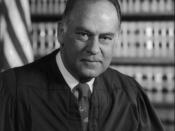Amendment Paper
I. First Amendment Text
II. What It Guarantees
III. Why It Was Important
IV. Supreme Court Cases and Public Trials
--NSPA v. Skokie
--Gobitis v. Minersville
-- Barnette v. West Virginia School Board
--Tinker v. Des Monies
V. The Censorship Issue
--Music
*Frank Zappa and the PMRC
--Books
--Obscenity
VI. Closing Remarks
Amendment 1
Congress shall make no law respecting an establishment of religion, or prohibiting the free exercise thereof; or abridging the freedom of speech, or of the press; or the right of the people peaceably to assemble, and to petition the government for a redress of grievances.
The First Amendment allows U.S. citizens to practice their own religions, petition the government, hold meetings, speak as they choose and print what they see fit in their press. The amendment has now extended to include non-verbal expressions like clothing or art. However, the First Amendment will not allow you to intimidate or harass others or break the law.
For example, religious sacrifice is not allowed in the U.S., and threatening phone calls are not protected under the First Amendment. A newspaper can be sued for libel if it knowingly prints information that is false.
The young U.S. chose to be a forerunner in freedom of speech, something now associated with democracy. American colonists remembered that in 1500's England, speaking out against the government was considered treason and was punishable by death. The English civil war in 1642 and the formation of a new government actually led to more restriction. In 1644, John Milton wrote Areopagitica, outlining points against censorship which are still used today. Finally, in 1689, the English Bill of Rights was passed allowing free speech-- to members of Parliament.
In 1735, John Peter Zenger was on trial in the American Colonies. New York governor William Cosby...



8th grader?
You put to shame other 8th graders. Just based on the polarization of the votes for and aganist you proves your ability to write well enough that the essay becomes about the issue and not the writing.
0 out of 1 people found this comment useful.